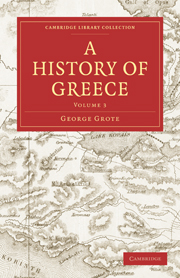Book contents
- Frontmatter
- Contents
- PART.II CONTINUATION OF HISTORICAL GREECE
- CHAPTER IX Corinth, Sikyôn, and Megara.—Age of the Grecian Despots
- CHAPTER X Ionic portion of Hellas.—Athens before Solon
- CHAPTER XI Solonian Laws and Constitution
- CHAPTER XII Eubœa.—Cyclades
- CHAPTER XIII Asiatic Ionians
- CHAPTER XIV Æolic Greeks in Asia
- CHAPTER XV Asiatic Dorians
- CHAPTER XVI Natives of Asia Minor with whom the Greeks became connected
- CHAPTER XVII Lydians.—Medes.—Cimmerians.—Scythians
- CHAPTER XVIII Phenieians
- CHAPTER XIX Assyrians.—Babylon
- CHAPTER XX Egyptians
- CHAPTER XXI Decline of the Phenicians.—Growth of Carthage
- CHAPTER XXII Western Colonies of Greece—in Epirus, Italy, Sicily, and Gaul
- CHAPTER XXIII Grecian Colonies in and near Epirus
- CHAPTER XXIV Akarnanians.—Epirots
- Plate section
CHAPTER X - Ionic portion of Hellas.—Athens before Solon
Published online by Cambridge University Press: 05 October 2010
- Frontmatter
- Contents
- PART.II CONTINUATION OF HISTORICAL GREECE
- CHAPTER IX Corinth, Sikyôn, and Megara.—Age of the Grecian Despots
- CHAPTER X Ionic portion of Hellas.—Athens before Solon
- CHAPTER XI Solonian Laws and Constitution
- CHAPTER XII Eubœa.—Cyclades
- CHAPTER XIII Asiatic Ionians
- CHAPTER XIV Æolic Greeks in Asia
- CHAPTER XV Asiatic Dorians
- CHAPTER XVI Natives of Asia Minor with whom the Greeks became connected
- CHAPTER XVII Lydians.—Medes.—Cimmerians.—Scythians
- CHAPTER XVIII Phenieians
- CHAPTER XIX Assyrians.—Babylon
- CHAPTER XX Egyptians
- CHAPTER XXI Decline of the Phenicians.—Growth of Carthage
- CHAPTER XXII Western Colonies of Greece—in Epirus, Italy, Sicily, and Gaul
- CHAPTER XXIII Grecian Colonies in and near Epirus
- CHAPTER XXIV Akarnanians.—Epirots
- Plate section
Summary
Having traced in the preceding chapters the scanty stream of Peloponnesian history, from the first commencement of an authentic chronology in 776 b.c, to the maximum of Spartan territorial acquisition, and the general acknowledgement of Spartan primacy, prior to 547 b.c, I proceed to state as much as can be made out respecting the Ionic portion of Hellas during the same period. This portion comprehends Athens and Eubœa—the Cyclades islands —and the Ionic cities on the coast of Asia Minor, with their different colonies.
In the case of Peloponnesus, we have been enabled to discern something like an order of real facts in the period alluded to—Sparta makes great strides, while Argos falls. In the case of Athens, unfortunately, our materials are less instructive. The number of historical facts, anterior to the So-lonian legislation, is very few indeed : the interval between 776 b.c. and 624 b.c, the epoch of Drako's legislation a short time prior to Kylon's attempted usurpation, gives us merely a list of archons, denuded of all incident.
In compliment to the heroism of Kodrus, who had sacrificed his life for the safety of his country, we are told that no person after him was permitted to bear the title of king: his son Medôn, and twelve successors—Akastus, Archippus, Thersip-pus, Phorbas, Megaklês, Diognêtus, Phereklês, Ariphrôn, Thespieus, Agamestôr, Æschylus, and Alkmæôn—were all archons for life. In the second year of Alkmæôn (752 b.c.), the dignity of archon was restricted to a duration of ten years: and seven of these decennial archons are numbered—Charops, Æsimidês, Kleidikus, Hippomenês, Leokratês, Apsandrus, Eryxias.
- Type
- Chapter
- Information
- A History of Greece , pp. 65 - 117Publisher: Cambridge University PressPrint publication year: 2010

